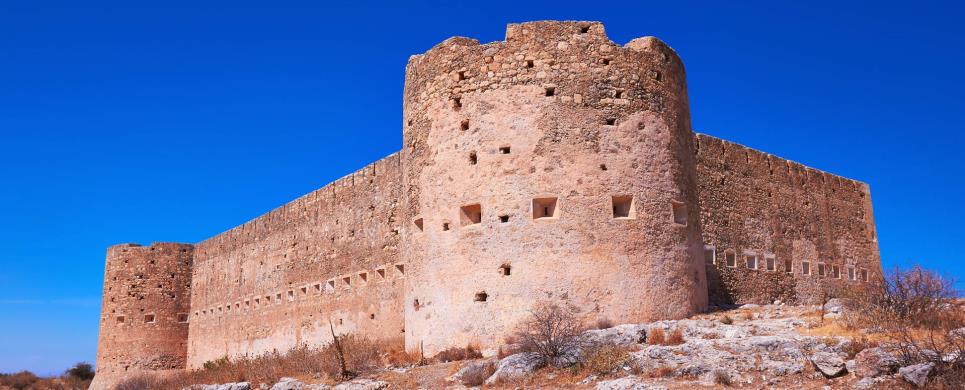Listed 12 sub titles with search on: Archaeological sites for wider area of: "KYDONIA Province CHANIA" .
APTERA (Ancient city) SOUDA
In the site there are very large, well-preserved, domed water reservoirs built during Roman times. There are also ruins from a Roman theatre in the extensive, mostly unexcavated site of Aptera. Recently further Hellenistic ruins have been located near the theatre.



MINOA (Ancient city) CRETE
In Marathi there are remains of the ancient city of Minoa. Minoa belonged
to Aptera, which is visible from Marathi on the other side of Souda Bay. The excavations
have revealed part of its harbour and some buildings dating from the second century
A.D.



APTERA (Ancient city) SOUDA
In the middle of the site there is a small temple dating from classical times, (2C B.C.). It is assumed that the temple was dedicated to a pair of gods, possibly Dimitra and Kori.



KYDONIA (Ancient city) CHANIA
The tomb belongs to the cemetery of the Hellenistic city of Kydonia and attests the relations of the city with Hellenistic Alexandria. It dates to the end of the 4th and the first half of the 3rd century B.C.
Large, rock-cut family tomb. A long dromos with steps leads to the entrance. Nine burial chambers with doors are arranged around a large central space. The names of the deceased are written above each door. The tomb is preserved under a modern building and can be visited by the public after arrangement with the Ephorate of Antiquities.
In 1981, the 25th Ephorate of Prehistoric and Classical Antiquities carried out a salvage excavation.
This text is cited Feb 2003 from the Hellenic Ministry of Culture URL below, which also contains images.


MALEME (Village) PLATANIAS
Large tholos tomb built in the ecphoric system. The burial chamber is square in plan, and the dromos leading to the entrance is 2 m. wide and 13.30 m. long. It dates to the Late Minoan III period and bears evidence for the Mycenean influence on Crete.
The tomb was excavated by the 25th Ephorate of Prehistoric and Classical Antiquities in 1966, and was found looted.
This text is cited Feb 2003 from the Hellenic Ministry of Culture URL below, which also contains image.


A Minoan tholos tomb of the Postpalatial Period is on the same road before the cemetery. A small sign points towards the grave. It is about 100 metres east along the hills. The tomb is on the right of the path. It has an unusually long path leading to the rectangular chamber. The tomb had been robbed but excavations in 1966 revealed two seals.



NEA ROUMATA (Settlement) MOUSSOURI


APTERA (Ancient city) SOUDA
Tel: +30 28210 44418, 94487, 90334
Aptera was founded in the Geometric period, although the city is mentioned
in the Linear B tablets found at Knossos
(A-pa-ta-wa). It reached a peak in the Hellenistic period, with intense commercial
and political activity. In the Roman period, the town had a more rural character.
It was destroyed by an earthquake in the 7th century AD and much later, in the
12th century, the Monastery of Hagios Ioannes Theologos (St. John the Baptist) was founded at the site.
The most important monuments of the site are:
- The Roman cisterns
- Bipartite temple, known as the "bipartite sanctuary", dated to the 5th-4th century BC
- Graves of the Geometric-Roman periods
- The fortification walls, preserved to a length of almost 4 kilometres. The main phase of construction belongs to the 4th century BC.
- The Roman bouleuterion
- The Late Byzantine monastery of Hagios Ioannes Theologos (St. John the Baptist)
- The Turkish fortress built in 1866-1869
KYDONIA (Ancient city) CHANIA
Tel: +30 28210 44418
Fax: +30 28210 94487
(Archeological research in the region of Kasteli Hania). Excavations, begun in 1964 and continuing up to the present time in collaboration with the Swedish Archeological School, have rendered invaluable evidence concerning the city. This shows Kasteli as an archaic centre of life and civilisation. Sections of two roads, one square and four houses have been unearthed in an area of 550 m2 and at a depth of 2m. Within the excavated area can be seen storage rooms, living quarters, a two-flight staircase, corridors, a kitchen with a cooking site, and a loom, as proven by several weaving weights found there. Equally important are the fragments of clay tablets in linear A scripture, seals made of clay and the unique seal known as “Master impression” depicting a multi-storeyed building complex in a rocky coastal landscape crowned with horns. A male figure, in a domineering pose, stands at the top.
This text is cited Oct 2003 from the Municipality of Chania URL below, which contains images.

Receive our daily Newsletter with all the latest updates on the Greek Travel industry.
Subscribe now!